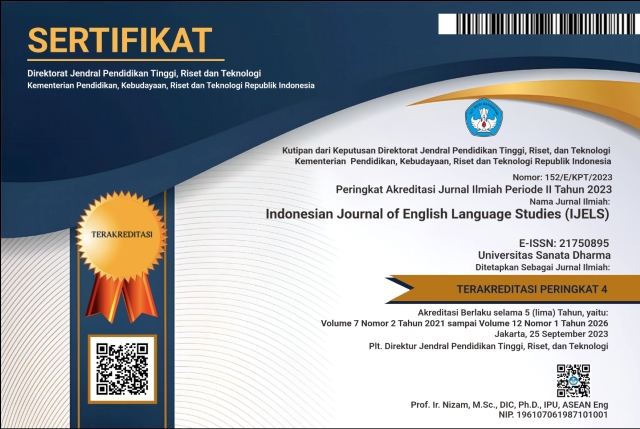Code-Switching and Portuguese Influence in the Invention of Tetun-Portu as a Creole
(1)
(*) Corresponding Author
Abstract
A creole is a pidgin that has attained the first generation of the speaker. The formation of a creole might be influenced by several factors and the two of them are code-switching and the influence of a dominant language. In relation to the two factors, there is a creole that might fit the situation. The creole is the Tetun-Portu language and the creole is presumably invented from the combination between the Tetun-Terik language and the Portuguese language. The backbone of the language might be adopted from the Tetun-Terik language but the codes have been dominated by the Portuguese language. The invention of the creole might be related to the Portuguese occupation in the Timor Island several centuries ago. Due to the interesting characteristics, the researcher would like to investigate the creole further. In conducting the study, the focus will be on how the code-switching influence the invention of the creole and the Portuguese influence within the invention of the creole itself. The findings of the study confirm that the Tetun-Portu language might be considered as a creole because it has completely different structures and it has adopted more codes from the Portuguese language.
Keywords: Creole, Tetun-Terik, Tetun-Portu, code-switching, Portuguese influence
Full Text:
PDFReferences
DeCamp, D., & Hancock, F. 1974. PIdgins and Creoles: Current Trends and Prospects. Washington, D.C.: Georgetown University Press.
Holmes, J. 2013. An Introduction to Sociolinguistics: Fourth Edition. New York: Routledge.
Language, S. o.-T.-P. 2018. Interview Session with the Speakers of Tetun-Terik Language and Tetun-Portu Language. (J. Z. Ma'u, Interviewer, June 17)
McWhorter, J. H. 1998. Identifying the Creole Prototype: Vindicating a Typological Class. Language, 788-818.
Scotton, C. M. 1982. The Possibility of Code Switching: Motivation for Maintaining Multilingualism. Anthropological Linguistics, 432-444.
Soedjatno, Solchan, Aminoedin, A., & Djajengwasito, S. 1992. Sistem Morfologi Kata Tugas Bahasa Tetum. Jakarta: Pusat Pembinaan dan Pengembangan Bahasa Departemen PEndidikan dan Kebudayaan.
St. Clair, R. N., & Murai, H. M. 1974. Code Switching in Hawaiian Creole. The Kansas Journal of Sociology, 75-82.
Suarjana, I. N., Ardana, I. G., Sudiarga, I. M., & Negara, N. P. 1995. Sastra Lisan Tetun. Jakarta: Pusat Pembinaan dan Pengembangan Bahasa Departemen Pendidikan dan Kebudayaan.
Timor, S. f. 2018. Informal FGD for Attaining Preliminary Data on Tetun-Portu Language. (J. Z. Ma'u, Interviewer, May 12)
TirtoID. 2017, November 8. Portugis Menjamah Nusantara - Mozaik Tirto. Retrieved June 16, 2018, from www.youtube.com.
Wardhaugh, R. 2006. An Introduction to Sociolinguistics: Fifth Edition. Blackwell Publishing: Oxford.
DOI: https://doi.org/10.24071/ijels.v5i1.2313
Refbacks
- There are currently no refbacks.

This work is licensed under a Creative Commons Attribution-ShareAlike 4.0 International License.
IJELS Journal Sinta 4 Certificate (S4 = Level 4)
We would like to inform you that Indonesian Journal of English Language Studies (IJELS) has been nationally accredited Sinta 4 by the Ministry of Education, Culture, Research and Technology of the Republic of Indonesia based on the decree No. Surat Keputusan 152/E/KPT/2023. Validity for 5 years: Vol 7 No 2, 2021 till Vol 12 No 1, 2026

This work is licensed under CC BY-SA.
Creative Commons Attribution-ShareAlike 4.0 International License
IJELS e-ISSN 2715-0895; IJELS p-ISSN 2442-790X
Indonesian Journal of English Language Studies (IJELS) is published twice a year, namely in March and September, by the English Language Studies (ELS) of the Graduate Program of Sanata Dharma University, Yogyakarta, Indonesia.


 IJELS p-ISSN:
IJELS p-ISSN: 











